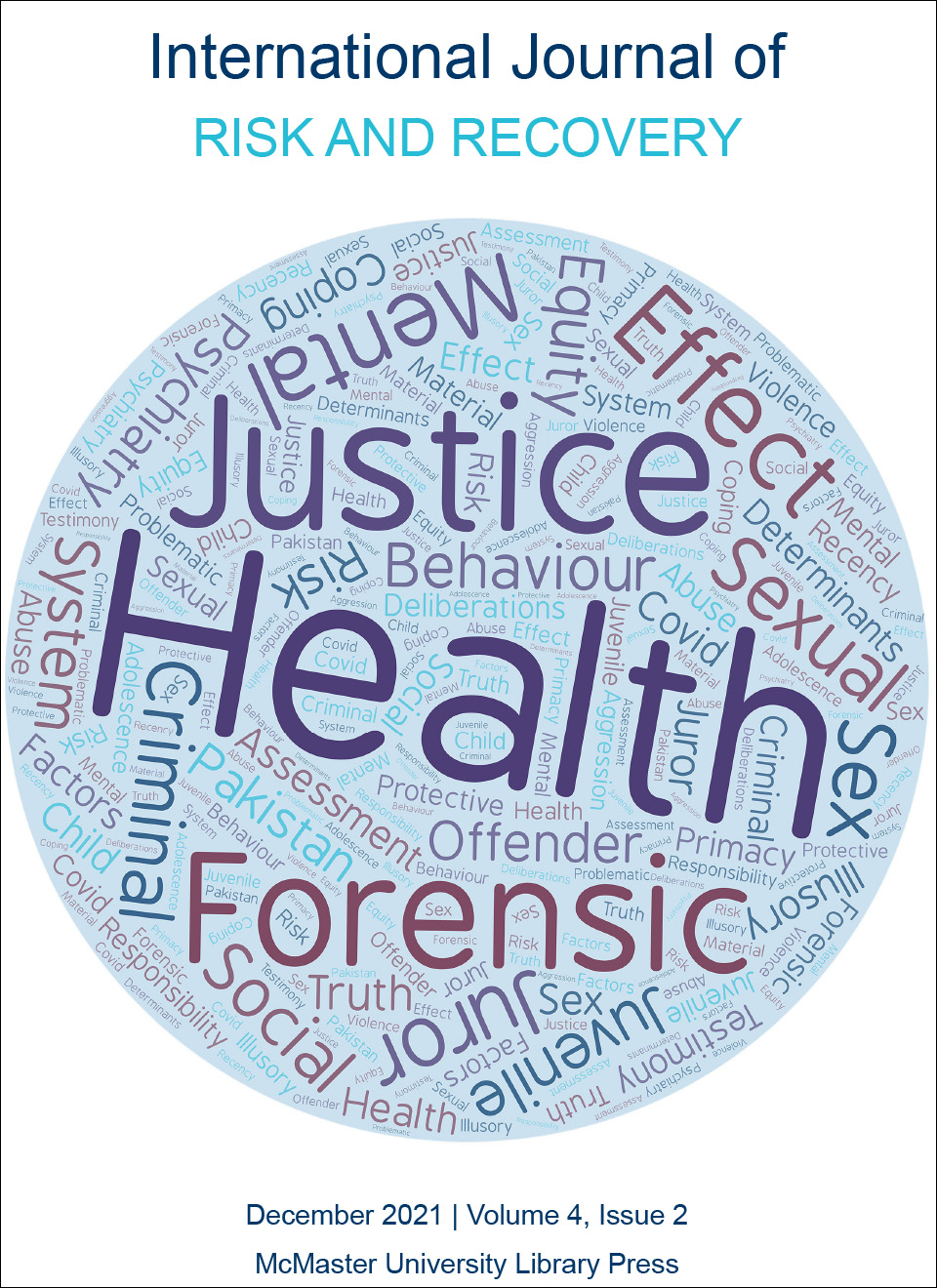The Impact of the Illusory Truth Effect and Location of Testimony in Juror Deliberations
DOI:
https://doi.org/10.15173/ijrr.v4i1.4339Keywords:
ITE, testimony, juror deliberations, primacy effect, recency effect, illusory truth effectAbstract
The illusory truth effect (ITE) is the tendency to believe false information as being accurate after it has been presented repeatedly over time. ITE has been shown to hold true in many different contexts; however, there have been no studies that examine the influence of ITE in jurors’ deliberation. Given the importance of weighing legally relevant facts in the decision-making process, and the potential influence of ITE, this study examined whether the repetition of key evidence in testimony matters in this context. This study also examined whether critical information would be influenced by the location of ITE. In that context, jurors may process critical information differently when introducing ITE early (i.e., primacy effect) or later (i.e., recency effect) in the vignette of a murder case. To examine this effect, 100 participants were recruited and asked to read a vignette where pertinent evidence related to a murder was strategically repeated throughout the case narrative. Participants were assigned to one of four groups: control; ITE throughout vignette; ITE at the beginning of vignette; and ITE at the end of vignette. After reading the vignette, participants were asked to complete a short questionnaire and provide a final decision about various aspects of the case. Results revealed that repetition of pertinent evidence matters. The placement of evidence also has the potential to influence jurors’ perceptions of certain case relevant details. These findings suggest that within a sensitive legal context, such as jurors weighing evidence of an accused’s culpability, ITE could alter one’s perception of the facts.
References
Gold V. Psychological manipulation in the courtroom. Nebraska Law Review. 1987;66(3):563-583. https://digitalcommons.unl.edu/nlr/vol66/iss3/11/.
Tanford S, Penrod S. Jury deliberations: Discussion content and influence processes in jury decision making. Journal of Applied Social Psychology. 1986;16(4):322-347. https://doi.org/10.1111/j.1559-1816.1986.tb01144.x.
Hasher L, Goldstein D, Roppino T. Frequency and the conference of referential validity. Journal of Verbal Learning and Verbal Behavior. 1977;16(1);107-112. https://doi.org/10.1016/S0022-5371(77)80012-1.
Wang W, Brashier N, Wing E, Marsh E, Cabeza R. On known unknowns: Fluency and the neural mechanisms of illusory truth. Journal of Cognitive Neuroscience. 2016;28(5):739-746. https://doi.org/10.1162/jocn_a_00923.
Fazio L, Brashier N, Payne B, Marsh E. Knowledge does not protect against illusory truth. Journal of Experimental Psychology: General. 2015;144(5):993-1002. https://doi.org/10.1037/xge0000098.
Gigerenzer G, Gaissmaier W. Heuristic decision making. The Annual Review of Psychology. 2011;62:451-82. https://doi.org/10.1146/annurev-psych-120709-145346.
Unkelbach C, Rom S. A referential theory of the repetition-induced truth effect. Cognition. 2017;160:110-126.
https://doi.org/10.1016/j.cognition.2016.12.016.
DiFonzo N, Beckstead J, Stupak N, Walders K. Validity judgments of rumors heard multiple times: The shape of the truth effect. Social Influence. 2016;11(1):22-39. https://doi.org/10.1080/15534510.2015.1137224.
Oppenheimer D.M. The secret life of fluency. Trends in Cognitive Sciences. 2008;12(6):237-241. https://doi.org/10.1016/j.tics.2008.02.014.
Dechêne A, Stahl C, Hansen J, Wänke M. The truth about the truth: A meta-analytic review of the truth effect. Personality and Social Psychology Review. 2009;14(2):238-257. https://doi.org/10.1177/1088868309352251.
Henkel L, Mattson M. Reading is believing: The truth effect and source credibility. Consciousness and Cognition. 2011;20(4):1705-1721. https://doi.org/10.1016/j.concog.2011.08.018.
Belcher A, Sinnott-Armstrong W. Neurolaw. Wiley Interdisciplinary Reviews. Cognitive Science. 2009;1(1):18-22. https://doi.org/10.1002/wcs.8.
Jones O, Marois R, Farah M, Greely H. Law and neuroscience. The Journal of Neuroscience. 2013;33(45):17624-17630. https://doi.org/10.1523/JNEUROSCI.3254-13.2013.
Morrison AB, Conway ARA, Chein JM. Primacy and recency effects as indices of the focus of attention. Frontiers in Human Neuroscience. 2014;24:1-14. https://doi.org/10.3389/fnhum.2014.00006.
Highhouse S, Gallo A. Order effects in personnel decision making. Human Performance. 1997;10(1):31-46.
https://doi.org/10.1207/s15327043hup1001_2.
Marsh J, Ahn W. Order effects in contingency learning: The role of task complexity. Memory & Cognition. 2006;34(3):568-576.
https://doi.org/10.3758/BF03193580.
Dennis M, Ahn W. Primacy in causal strength judgments: The effect of initial evidence for generative versus inhibitory relationships. Memory & Cognition. 2001;29(1):152-164. https://doi.org/10.3758/BF03195749.
R. v. Kionke, 2017 MBQB 60 (CanLII).https://www.canlii.org/en/mb/mbqb/doc/2017/2017mbqb60/2017mbqb60.html.
Leippe M, Eisenstadt D, Rauch S, Seib H. Timing of eyewitness expert testimony, jurors’ need for cognition, and case strength as determinants of trial verdicts. Journal of Applied Psychology. 2004;89(3):524-541. https://doi.org/10.1037/0021-9010.89.3.524.
Miller N, Campbell D. Recency and primacy in persuasion as a function of the timing of speeches and measurements. Journal of Abnormal and Social Psychology. 1959;59(1):1-9. https://doi.org/10.1037/h0049330.
Brewer P, Ley B. Media use and public perceptions of DNA evidence. Science Communication. 2009;32(1):93-117. https://doi.org/10.1177/1075547009340343.
Downloads
Published
How to Cite
Issue
Section
License
Copyright (c) 2021 Alexandrea Johnston, Daniel Ambrosini, Bruno Losier

This work is licensed under a Creative Commons Attribution 3.0 Unported License.
Copyright Notice
Authors who publish with this journal agree to the following terms:
- Authors retain copyright of their work and grant the International Journal of Risk and Recovery the right of first publication with the work simultaneously licensed under a Creative Commons Attribution License. This allows others to share the work with an acknowledgement of the work’s authorship and initial publication in this journal.
- Authors are able to enter into separate, additional contractual arrangements for the non-exclusive distribution of the journal’s published version of the work (e.g., post it to an institutional repository or publish it in a book) with an acknowledgement of its initial publication in this journal.
- Authors are permitted and encouraged to post their work online (e.g., in institutional repositories or on their websites) before and during the submission process as it can lead to productive exchanges, as well as earlier and greater citation of published work. (See The Effect of Open Access.)

